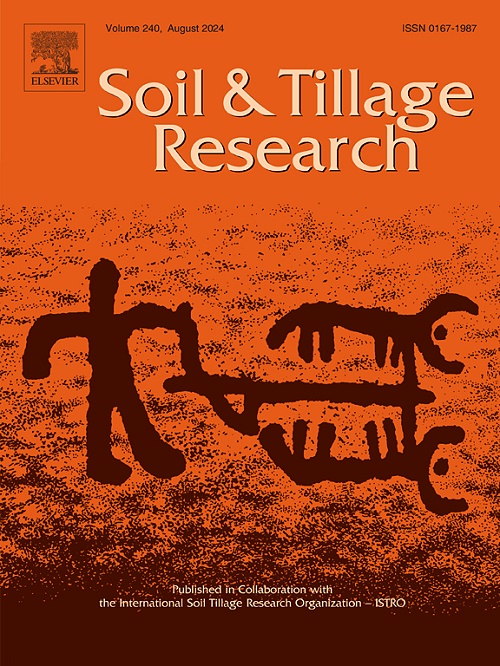A six-site field study on assessing the suitability of conservation and conventional tillage in the black soil region, Northeast China
IF 6.1
1区 农林科学
Q1 SOIL SCIENCE
引用次数: 0
Abstract
In Northeast China’s primary granary, long-term conventional tillage (CT) has led to significant soil degradation in the high-fertility black soil. Conservation tillage (CS) presents an opportunity to preserve soil quality but may reduce crop yield. The suitability of CT and CS in black soil regions and underlying mechanisms are not clear. This study aimed to investigate the impact of CT and CS on soil quality, crop yield and associated influencing factors at a regional scale. A comprehensive field experiment spanning six sites across the black soil region was conducted to evaluate the effects of rotary tillage (RT, traditional practice), no-tillage (NT, a form of CS), and deep ploughing (DP, representing CT) on maize yield and soil physicochemical properties. Results revealed that NT significantly enhanced total and available soil nutrients, along with soil organic carbon (SOC) content in surface layer (0–20 cm), compared to RT. Conversely, DP improved these soil properties in the subsurface layer (20–40 cm) across various sites. Notably, SOC accumulation rates were higher in warmer than cooler regions under NT. NT also significantly increased soil water content throughout the entire growth season and subsequently decreased soil temperature during the seeding stage, particularly in semi-arid areas. DP slightly increased soil water content and maintained a similar soil temperature compared to RT in both semi-arid and semi-humid areas. Variable partitioning analysis (VPA) highlighted the significant influence of soil bulk density, nutrient contents, and hydrothermal properties on yield variation under NT and DP compared to RT. Under NT, these factors contributed to 77 %, 81 %, and 63 % of yield variation, respectively, while for DP, the contributions were 65 %, −33 %, and 70 %. Our findings suggest that NT effectively preserves soil quality, conserves water, and sequesters carbon in semi-arid areas, leading to optimal maize production. Alternatively, DP with straw incorporation shows more variable yields and promises more positive outcomes in semi-humid areas.
东北黑土区保护性耕作与常规耕作适宜性评价的六点实地研究
在东北初级粮仓,长期常规耕作导致高肥力黑土土壤明显退化。保护性耕作(CS)提供了保持土壤质量的机会,但可能会降低作物产量。CT和CS在黑土地区的适宜性及其机制尚不清楚。本研究旨在研究在区域尺度上CT和CS对土壤质量、作物产量及相关影响因素的影响。在黑土区6个试验点进行了综合田间试验,评估了传统轮作(RT)、免耕(NT, CS的一种形式)和深耕(DP,代表CT)对玉米产量和土壤理化性质的影响。结果表明,与rt相比,NT显著提高了表层(0 ~ 20 cm)土壤总养分和速效养分,以及土壤有机碳(SOC)含量。相反,DP改善了不同地点表层(20 ~ 40 cm)土壤的这些特性。土壤有机碳积累速率在暖区显著高于冷区。在整个生长季,土壤含水量显著增加,苗期土壤温度显著降低,尤其是在半干旱区。在半干旱和半湿润地区,与RT相比,DP略微增加了土壤含水量,保持了相似的土壤温度。变量分配分析(VPA)显示,土壤容重、养分含量和水热特性对NT和DP下产量变化的影响显著。在NT下,这些因素对产量变化的贡献率分别为77 %、81 %和63 %,而DP的贡献率分别为65 %、- 33 %和70 %。我们的研究结果表明,在半干旱地区,NT有效地保持了土壤质量,保持了水,并固碳,从而实现了最佳的玉米产量。另外,秸秆还田的DP在半湿润地区表现出更多的可变产量,并有望取得更积极的成果。
本文章由计算机程序翻译,如有差异,请以英文原文为准。
求助全文
约1分钟内获得全文
求助全文
来源期刊

Soil & Tillage Research
农林科学-土壤科学
CiteScore
13.00
自引率
6.20%
发文量
266
审稿时长
5 months
期刊介绍:
Soil & Tillage Research examines the physical, chemical and biological changes in the soil caused by tillage and field traffic. Manuscripts will be considered on aspects of soil science, physics, technology, mechanization and applied engineering for a sustainable balance among productivity, environmental quality and profitability. The following are examples of suitable topics within the scope of the journal of Soil and Tillage Research:
The agricultural and biosystems engineering associated with tillage (including no-tillage, reduced-tillage and direct drilling), irrigation and drainage, crops and crop rotations, fertilization, rehabilitation of mine spoils and processes used to modify soils. Soil change effects on establishment and yield of crops, growth of plants and roots, structure and erosion of soil, cycling of carbon and nutrients, greenhouse gas emissions, leaching, runoff and other processes that affect environmental quality. Characterization or modeling of tillage and field traffic responses, soil, climate, or topographic effects, soil deformation processes, tillage tools, traction devices, energy requirements, economics, surface and subsurface water quality effects, tillage effects on weed, pest and disease control, and their interactions.
 求助内容:
求助内容: 应助结果提醒方式:
应助结果提醒方式:


